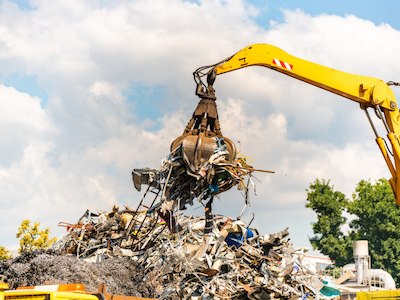Aluminum Scrap Markets

June 24, 2025
America's aluminum story: Scrap savvy and tariff turbulence
Written by Gabriella Vagnini
Here are the numbers: According to the USGS, the U.S. produced about 670,000 metric tons (mt) of primary aluminum in 2024. That’s down 11% from the year before. Meanwhile, secondary aluminum – recycled content – totaled 3.6 million mt (2 million from factory scrap, 1.6 million from old scrap). Add in 4.8 million mt of imports, and total supply hit 9.07 million mt.
Now subtract 3 million mt of exports, tack on a minor 230,000 mt stock adjustment, and the final number we land on is 4.3 million mt of apparent aluminum consumption in the U.S.
Scrap is the cash cow
Recycled aluminum now fuels over 80% of U.S. supply. It uses just a fraction of the energy compared to primary aluminum. That’s a major win for both cost and carbon. With export markets tightening, U.S. recyclers held onto more material in 2024. Domestic demand for secondary was just too strong to let it go.
While primary aluminum faces a 50% import tariff, recycled aluminum and scrap are untouched. That’s given local mills a reason to gobble it up and outbid foreign buyers.
Tariffs reshaped the market
Trump’s latest round of tariffs doubled duties on imported primary aluminum to 50%. Scrap was left alone. The result? A rush into the secondary market. The Midwest Premium climbed to a record 62.5 cents per pound in June and could still test 70.
Producers like Century, Matalco (Rio & Triple M), and Alcoa aren’t complaining. They’re suddenly more competitive against overseas producers. But buyers, the ones making beverage cans, car parts, and industrial components, are seeing those costs pile up. Some, like Coca-Cola, are hunting for workarounds.
Primary production is still a ghost of its former self
Once upon a time, the U.S. had a serious primary production base. Now, we’re down to just a handful of smelters, many of them barely humming. Between high electricity prices and long lead times to restart, it’s no surprise primary output is stuck around 52,000 mt/month. That’s about 50%-55% of our operating capacity.
We are not rebuilding that part of the supply chain without major changes in energy policy or investment. Until then, secondary will keep doing the heavy lifting.
Market outlook is mixed
There’s no shortage of aluminum globally. Alumina markets are well-supplied, which helps ease cost pressures. But between tariffs, geopolitical noise, and trade battles brewing in Europe over scrap exports, pricing and supply risks remain high.
Spot aluminum prices in the U.S. reached $1.56/lb in February, a 34% jump from the year before. Exports of plate, sheet, and foil dropped nearly 5% year over year, showing weakness in overseas demand.
Down-to-business summary
- U.S. supply is overwhelmingly backed by secondary aluminum
- Demand is holding steady around 4.3 million mt
- Tariffs are helping domestic producers but hiking costs for consumers
- Secondary aluminum will remain the backbone of U.S. consumption
- Watch out for trade tensions and global price volatility
Where we’re headed
If you want cheap domestic aluminum, the answer is recycled content. Rebuilding smelting capacity in the U.S. will take years, and only if energy costs come down and policy lines up. Right now, the economics just don’t support it.
If you’re a buyer, it’s time to hedge smart and keep a close eye on secondary markets. If you’re a policymaker, focus on strengthening domestic recycling systems and locking in low-cost power. Because whether we like it or not, we’re riding the scrap wave, and it’s not slowing down.







